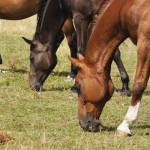Grazing and Browsing in Horses

Horses are generally thought of as grazers (animals that eat grass) as opposed to browsers (animals that eat leaves, shrubs, and brushy plants). Is grazing a result of modern management practices rather than a reflection of the horse’s basic nature? This question is being addressed by a project that will investigate the role of browsing on behavior and nutrition in domesticated horses.
Diets of feral horses in Australia have been reported to include a substantial portion of shrubs and tree foliage. It is suggested that the horses may browse foliage for medicinal purposes or to supplement their diets.
Many horse owners in other regions have observed their horses chewing on a mouthful of tree leaves or sampling twigs from bushes, but because many horse pastures contain primarily grass and legumes, horses have relatively few opportunities to browse other plants.
Little attention has been directed at systematically listing the number and types of foliage eaten by horses in a natural setting. These plants may be chosen by free-roaming horses because of curiosity, availability during drought, flavor, odor, or for other reasons.
In a presentation at the Australian Equine Science Symposium, researchers from New South Wales, Australia, described a study that will look at the time spent by horses in browsing behavior as well as the nutritional profiles and palatability of various types of tree and shrub foliages. The study will use a horse industry survey to collect information from horse owners about their observations on incidences of browsing and types of foliage browsed.








